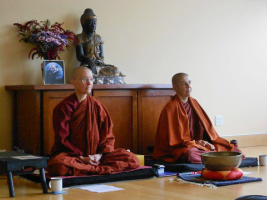Shedding Light on the Bhikkhunīs & the Great Founding Women of Borobudur
Ayyā Tathālokā Bhikkhunī| Image 1: Bhikkhunīs of Borobudur |
Chronologically, this post falls between part 4 and part 5 in this Awakening Buddhist Women blog series. Prepared especially for the 14th Sakyadhita International Conference in Yogyakarta, this previously unpublished extract was presented live at the Sakyadhita Conference.
“Light of the Kilis” is based on research materials gathered from travelogues, local oral traditions, dedicatory inscriptions, monuments, and statuary, or what remains of these within their cultural and historical context. The materials span a time period of more than 2000 years, from the 3rd century BCE up to modern times.
Here we focus on the 8th and 9th centuries and materials that are of direct relevance to the Sakyadhita Conference locale and of special interest and value to women in Buddhism. I touch on the feminine aspect of Indonesian candis, the appearance and role of both the esoteric Bhagavatī Aryā Tārā, the human queen Devī Tārā, and her daughter (or granddaughter) Śrī Sanjiwana Prāmodhavardhanī, the latter two Buddhist women being key persons involved with the foundation and establishment of the world-famous Borobudur monument. I also highlight images of bhikṣuṇīs and the dual sangha (bhikkhus and bhikkhunīs) that are portrayed on three levels of the wall reliefs of the Borobudur monument. These images are of outstanding historical value, because we can glean from them unparalleled visual knowledge of Buddhist women’s monastic way of life at the time they were created. I review and describe these images in the context of the Dharma teaching stories they illustrate – shining examples of women’s leadership and eminence in the Buddhist sangha, as they were conceived of and understood during this period.



